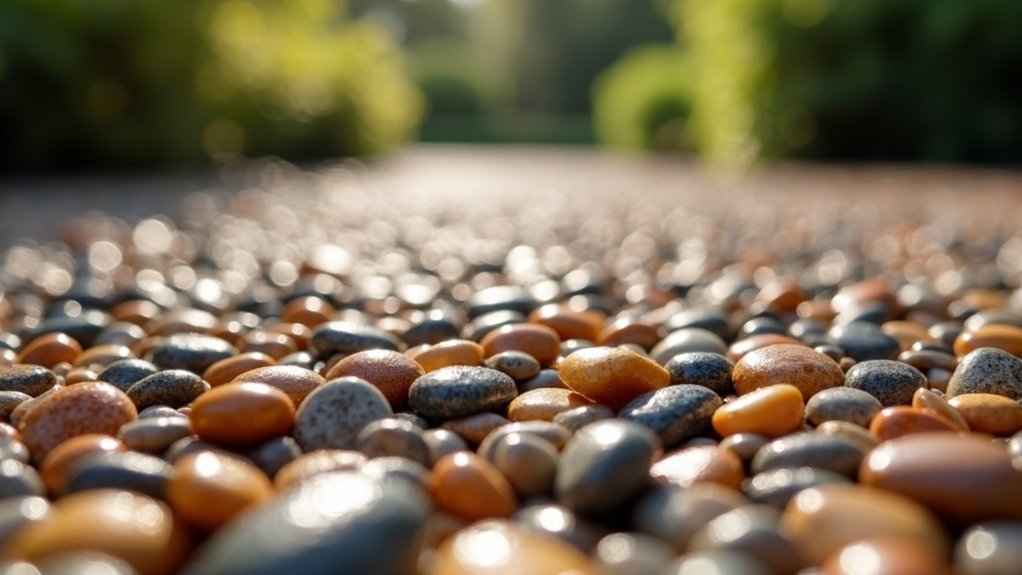Choosing the right stones for resin-bound gravel isn’t as straightforward as many think. Whilst popular belief suggests any aggregate will do, the size, type and texture of stones make a real difference to both look and function. Many DIYers and contractors wrongly assume all stones provide the same drainage or wear resistance – they don’t. A properly balanced mix ensures better water drainage and stands up to British weather, particularly important for our rainy climate. Think of it like choosing the right trainers for running versus walking – each serves a specific purpose. The foundation work matters just as much; skimp on base preparation and even the finest aggregate mix won’t perform properly. For best results, consider locally sourced materials, which often prove more cost-effective and environmentally sound.
Key Takeaways
Resin-Bound Gravel: Common Myths About Stone Selection
- Proper drainage isn’t just about the resin – well-prepared ground and correct aggregate choices allow up to 95% of rainfall to filter through naturally.
- Don’t fall for the ‘smaller is better’ myth. A proper mix of stone sizes creates the best drainage channels, stopping those annoying puddles from forming.
- Whilst tough stones are vital, even the hardiest aggregates need proper laying. Get it wrong, and you’ll see crumbling and fading, no matter how good your stones are.
- Think a quick sweep now and then will do? Think again. Regular hoovering stops blocked pores, keeps water flowing, and prevents flooding and summer heat spots.
- Local stone isn’t just about looking good – it cuts transport costs and carbon footprint. Many UK quarries offer brilliant recycled options that perform just as well as new aggregate.
Understanding Aggregate Types and Their Impact on Aesthetics
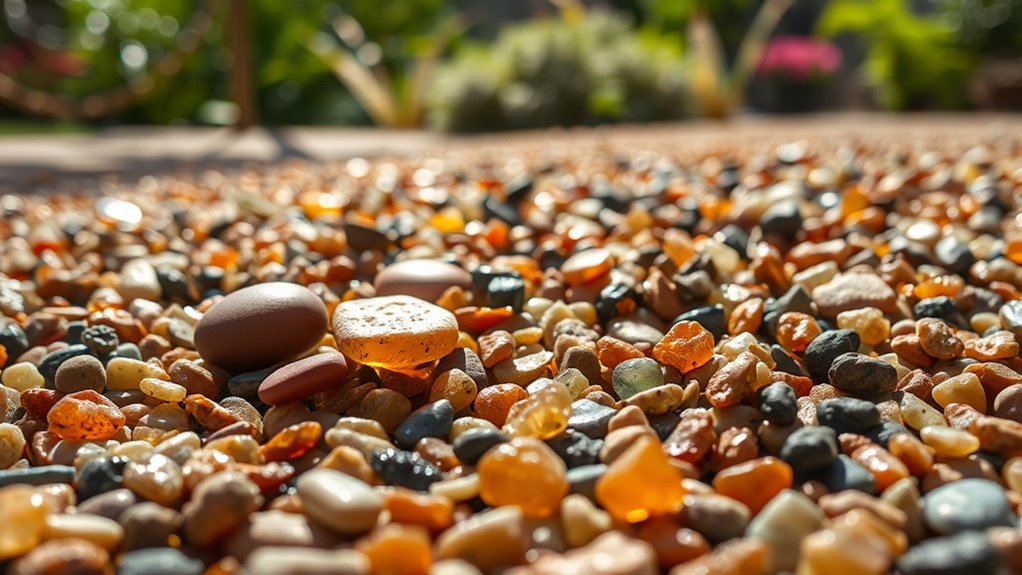
The choice of aggregates dramatically shapes how resin-bound gravel surfaces look in your outdoor space. Light-coloured stones help brighten driveways and patios, whilst darker aggregates mask dirt and reduce glare – particularly useful for high-traffic areas. Think of smooth, polished stones creating a contemporary finish, much like you’d see in modern garden designs, whilst rougher aggregates offer a more traditional, rustic appearance that suits period properties. Mixing different textures adds depth and character – imagine combining smooth Thames Valley pebbles with angular granite chips for a distinctive finish. The stones’ mineral makeup matters too; some hold their colour better than others when exposed to British weather. Quartz and granite, for instance, maintain their appearance far longer than limestone, making them ideal for long-term durability in resin-bound applications. Additionally, using washed, kiln-dried stones ensures optimal bonding and reduces maintenance issues. When choosing your aggregates, consider how they’ll complement your property’s style and serve practical needs. A blend of warm-toned aggregates might suit a Cotswold stone house, whilst sleek grey granite could perfectly match a modern build.
The Role of Aggregate Size in Resin Bound Systems
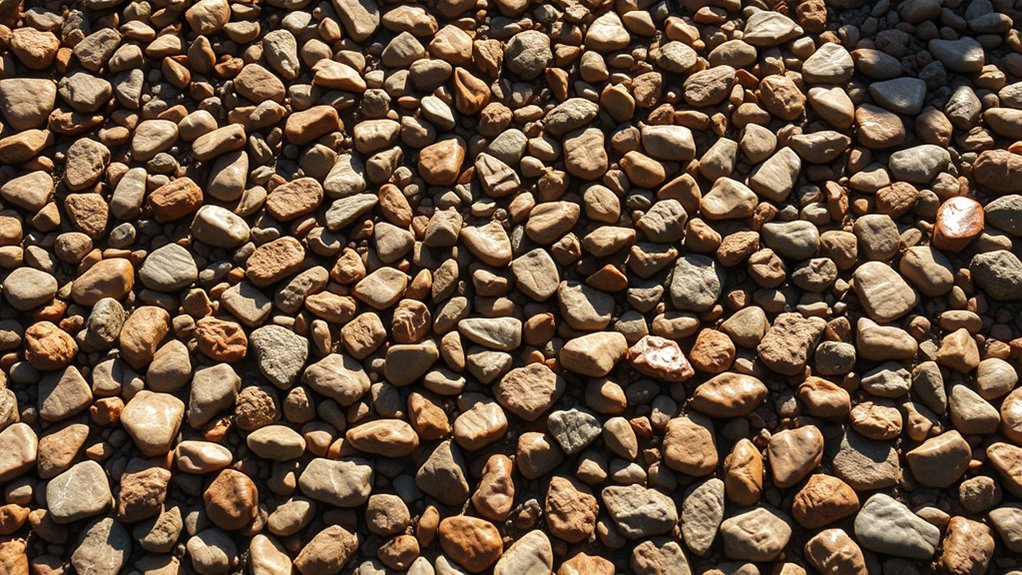
The size of aggregates in resin bound systems plays a vital role in both looks and function.
Smaller stones (2-3mm) deliver a sleek finish, perfect for paths and patios. Larger aggregates (6-10mm) offer better drainage and can handle heavier traffic, making them ideal for driveways and car parks. The right size choice ensures your surface not only looks smart but also manages rainwater effectively, preventing puddles and waterlogging. Additionally, selecting the right aggregate size ensures your surface is SUDS compliant, promoting effective water drainage and preventing pooling. In fact, using UV-stable solutions can also reduce long-term maintenance concerns, ensuring your driveway remains beautiful over time.
When selecting aggregates, consider where you’ll use the surface – a smooth finish for garden paths, or a robust mix for areas that need to support vehicles.
Impact on Aesthetics
The size of aggregates in resin-bound surfaces dramatically affects their look and feel. Medium-sized stones create a balanced appearance, whilst larger ones add striking texture – perfect for modern garden designs. Smaller aggregates deliver a smoother finish that’s particularly suited to walkways and patios. Additionally, the choice of resin types can influence the overall performance and aesthetic appeal of the surface, ensuring it meets both visual and functional requirements. Properly graded aggregates ensure a tighter fit, leading to stronger surfaces that are both durable and visually appealing.
Colour choices are equally important. From light limestone to dark granite, the natural stone options available let you create distinct looks. You can even incorporate custom patterns or company logos, making it easy to match your driveway or patio with your home’s existing features. Think of it like choosing tiles for your kitchen – the size and colour of each piece work together to create the overall effect you’re after. Whether you’re aiming for a contemporary look or something more traditional, the right combination of aggregates will help achieve it.
Drainage Efficiency Factors
Drainage efficiency in resin bound surfaces largely depends on stone size. The smaller stones (1-3mm) create a tightly packed surface that’s both permeable and stable – think of water passing through sand at the beach.
Adding slightly bigger stones (2-5mm) creates better-connected spaces for water to flow through, much like how a gravel path drains quickly after rain. Well-designed systems can handle up to 850 litres of water per minute for each square metre, which is vital for British weather conditions.
Using stones that are too small blocks the gaps, causing puddles to form – similar to a clogged sink.
The best approach mixes different stone sizes to create a strong surface that lets water drain freely into the ground below. It’s like building a good garden path: you need the right mix of materials to handle both foot traffic and rainfall effectively.
Misconceptions About Permeability and Drainage Capabilities
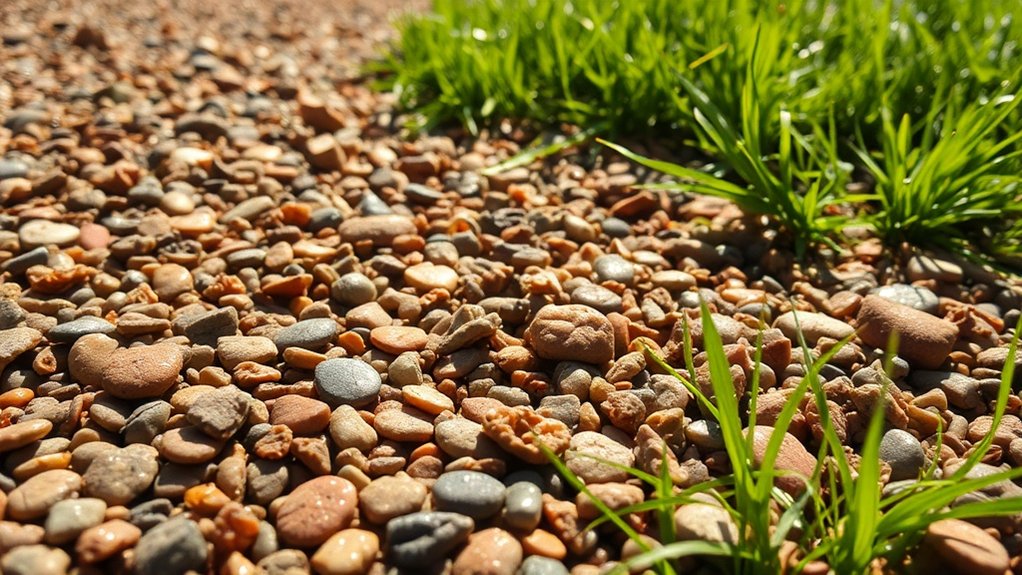
Common misunderstandings about permeability and drainage often cause costly mistakes in UK building projects. Contrary to popular belief, resin-bound gravel is highly permeable, allowing up to 95% of rainwater to filter through naturally. The mix typically contains 93% stone aggregate and 7% resin, creating tiny spaces that let water pass easily.
Many builders wrongly assume resin-bound surfaces drain water by themselves. In fact, proper drainage depends heavily on the ground preparation underneath. Think of it like a coffee filter – even the best filter needs somewhere for the water to go.
To keep these surfaces working properly, regular hoovering prevents dirt and leaves from blocking the drainage channels.
When properly maintained, resin-bound surfaces help prevent local flooding and reduce heat build-up in urban areas – particularly useful for British weather conditions.
The Importance of Base Preparation for Aggregate Performance
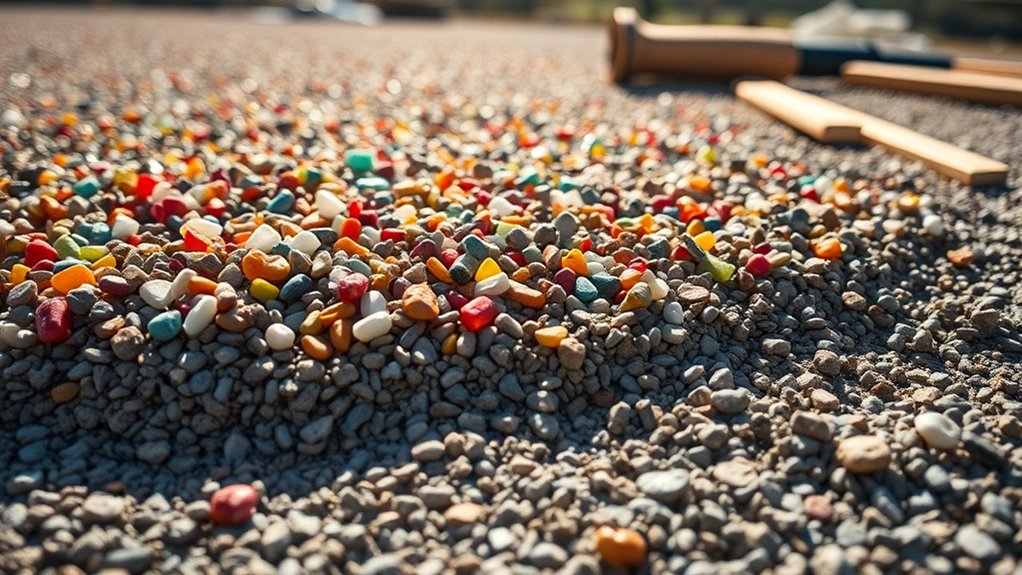
Proper base preparation is crucial for aggregate performance. A stable base prevents cracking and shifting in resin-bound gravel surfaces, regardless of the aggregate quality used.
| Base Material | Load-Bearing Capacity | Maintenance Needs | Curing Time |
|---|---|---|---|
| Concrete | High | Moderate | 28 days |
| Tarmac | Moderate | Low | 7 days |
| Compacted Type 3 | High | Low | Immediate |
| Loose Gravel/Sand | Low | High (frequent) | Not suitable |
Think of the base as your driveway’s foundation – much like a house, it needs solid groundwork. Common options include concrete, which offers excellent strength but requires lengthy curing, and tarmac, which provides a quicker solution. Compacted Type 3 aggregate delivers immediate stability, whilst loose materials simply won’t cut it.
Regular maintenance, including sweeping and levelling, keeps your resin-bound surface in top condition.
Evaluating Durability and Lifespan of Different Aggregate Choices
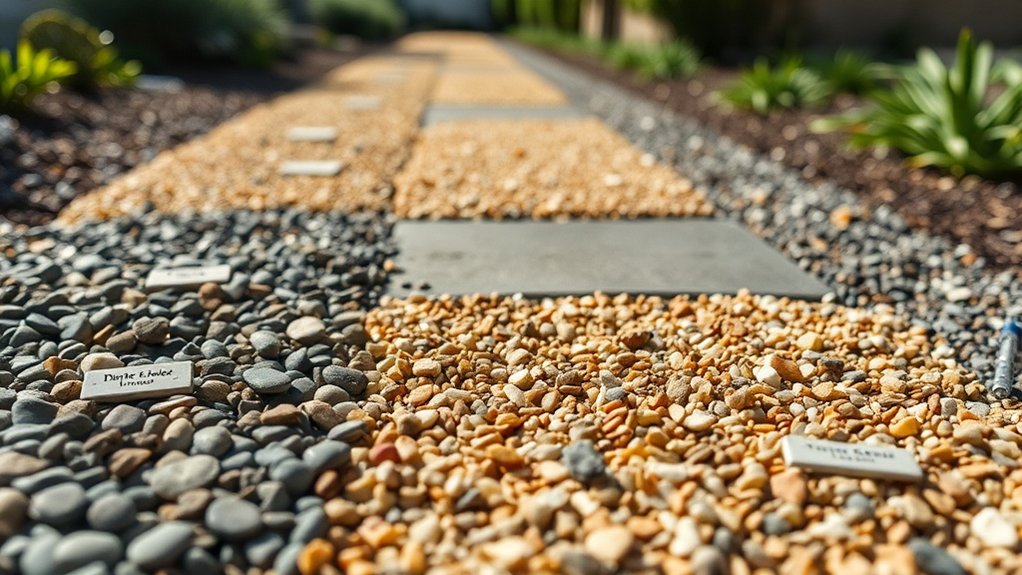
Choosing the right aggregate size and type makes a massive difference to how long your resin-bound surface will last. Smaller stones tend to wear better and stay put, whilst larger ones can become loose if there’s not enough resin to hold them.
Think of it like this: granite aggregates will outlast limestone ones, much like how a diamond ring holds up better than a chalk pendant.
The resin quality matters just as much – you’ll want one that properly grips the stones, preventing them from breaking away over time. British weather takes its toll too, so it’s worth picking aggregates that can handle our rain and seasonal changes.
For best results, opt for weather-resistant stones that won’t crumble or fade when exposed to the elements.
Mind you, even the toughest aggregate needs proper installation. A well-chosen combination of stone size, hardness and resin type will ensure your driveway or path stays smart and serviceable for years to come.
Sustainability Considerations in Aggregate Selection for Resin Bound Gravel
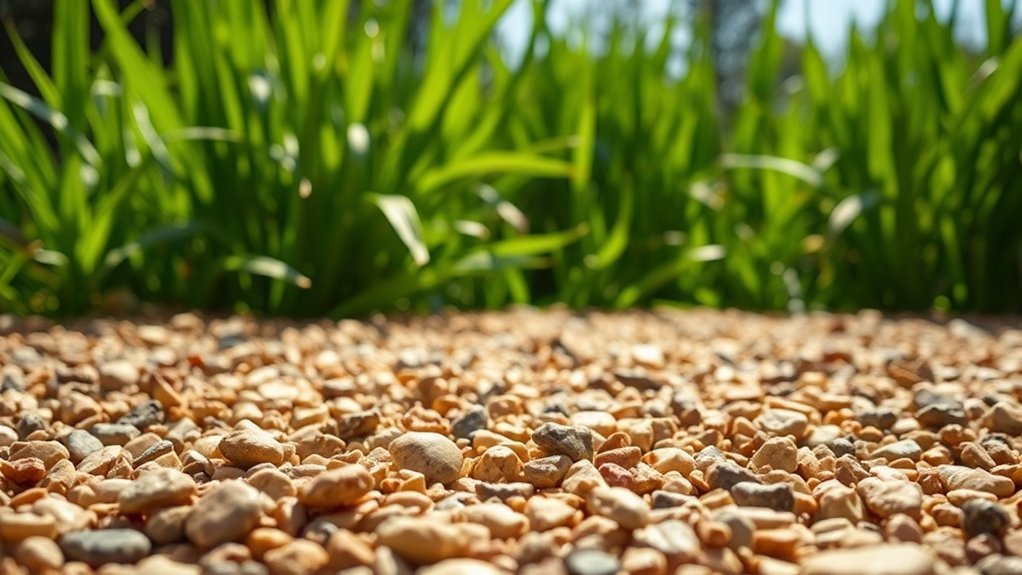
Selecting sustainable aggregates for resin bound gravel requires careful consideration of recycled materials and local sources.
Recycled aggregates, such as crushed glass or reclaimed stone, offer a practical way to support the UK’s circular economy whilst reducing landfill waste.
Sourcing from nearby quarries and suppliers cuts transport miles and carbon emissions, making your project greener.
For example, choosing Welsh slate from North Wales rather than imported stone from Italy dramatically reduces the project’s carbon footprint.
These sustainable choices needn’t compromise quality – many recycled materials perform just as well as virgin aggregates.
Recycled Aggregate Benefits
Recycled aggregates deliver key sustainability benefits when used in resin-bound gravel surfaces. The use of crushed glass and reclaimed stone reduces the demand for new quarried materials whilst cutting construction waste. Rather than sending these materials to landfill, they’re repurposed effectively – up to 80% of resin-bound gravel can be recycled at the end of its life.
The environmental impact is significant. By choosing recycled aggregates, you’ll use less energy in production and lower carbon emissions compared to virgin materials. Common examples include recycled glass from bottles and jars, and crushed concrete from demolition sites. This approach helps preserve natural habitats that would otherwise be quarried for new stone.
For UK construction projects, recycled aggregates offer a practical way to meet sustainability targets whilst maintaining quality standards. The finished surface performs just as well as those made with new materials, making it a sensible choice for driveways, paths and commercial developments.
Local Sourcing Impact
The local sourcing of aggregates for resin-bound gravel offers clear benefits for both the environment and UK construction sector.
By using nearby quarries, we cut down on lorry journeys, which means fewer emissions and less traffic on our roads. This approach directly supports British quarries and suppliers, keeping money in local communities and creating more reliable supply chains.
Local materials often work better for UK conditions, as they’re naturally suited to our climate and soil types.
Take the Peak District’s limestone or Cornwall’s granite – these proven materials have served local builders for generations.
Working with nearby suppliers also means better oversight of extraction practices and environmental standards.
Using local aggregates helps achieve lower carbon footprints and typically results in more durable installations, reducing the need for replacements and cutting down on waste.
It’s a practical way to balance environmental responsibility with good business sense whilst supporting British industry.
Frequently Asked Questions
Can I Mix Different Aggregates for a Unique Appearance?
Absolutely – mixing different aggregates creates striking visual effects in concrete. Common combinations include blending local pebbles with crushed granite or mixing limestone with decorative glass chips. Just stick to proper mixing ratios and ensure all materials are compatible. For best results, test small batches first to check the final appearance before committing to larger projects.
Do Colors Fade Over Time With Resin Bound Surfaces?
Resin-bound surfaces do experience colour fading over time. To maintain the best colour stability, opt for premium UV-stable resins and quality aggregates. Regular maintenance and protection from harsh weather will help preserve your surface’s original vibrancy, much like caring for a garden patio or driveway. Think of it as suncream for your surface – the better the protection, the longer it lasts.
What Is the Best Aggregate for High-Traffic Areas?
For high-traffic zones, angular crushed stone or stabilised decomposed granite are top choices. These aggregates offer excellent durability and resist shifting, making them ideal for busy paths, driveways and commercial spaces. Their jagged shape helps them lock together firmly, creating a sturdy surface that withstands constant foot and vehicle traffic.
Can I Use Non-Natural Aggregates for Resin Bound Systems?
Non-natural aggregates can be used in resin bound systems, though natural aggregates typically offer better reliability and proven performance. Before using alternatives like recycled glass or synthetic materials, it’s vital to test their compatibility with your chosen resin system. Poor matches can lead to reduced durability and inconsistent finish quality. For best results, consult with your resin supplier about approved aggregate options.
How Do I Choose Aggregates That Complement My Home’s Design?
Choose aggregates that match both your home’s colour scheme and architectural character. For classic British homes, grey or buff-coloured aggregates work well with stone or brick façades. Modern properties benefit from sleek, dark aggregates that complement contemporary materials. Consider local examples – a Victorian terrace might suit traditional cream or pink-tinted gravel, whilst a new-build could handle bolder blacks or silvers. Match your driveway or garden aggregates to existing materials like roof tiles or window frames for a cohesive look.
Conclusion
The right aggregate choice for resin-bound gravel proves as crucial as proper foundations for a building. Your selection affects how the surface looks, drains and lasts. Different aggregates offer distinct qualities – knowing these differences matters. By seeing through common misconceptions, you’ll achieve a resin-bound surface that’s both attractive and durable. Think of it as investing in quality building materials – get it right at the start, and you’ll reap the benefits for years to come.
